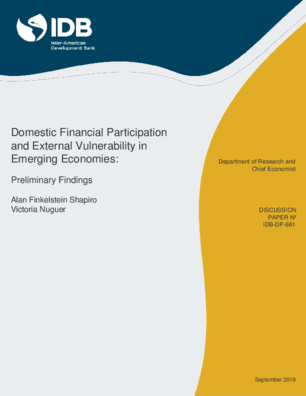Domestic Financial Participation and External Vulnerability in Emerging Economies: Preliminary Findings
Date
Sep 2019
The Global Financial Crisis (GFC) of 2008-2009 highlighted the role of the banking system as an important propagation mechanism of U.S. financial shocks to emerging economies (EMEs). Recent evidence shows that compared to advanced economies (AEs), emerging economies (EMEs) exhibit considerably lower levels of firm participation in the domestic banking system, leading several EMEs to promote greater firm domestic financial participation. What are the implications of this greater
firm participation in the banking system for the response to external financial shocks, such as those experienced by EMEs during the GFC? We build a two-country RBC model with banking frictions, endogenous firm entry, and limited domestic financial participation by firms. Using the model, we show that greater firm financial participation in EMEs limits the effect of adverse external financial shocks on EME financial and macro aggregates, with endogenous firm entry playing a critical role in
the volatility-reducing effects of greater firm financial participation in EMEs. We provide empirical evidence for EMEs that broadly supports our model findings and mechanisms.
firm participation in the banking system for the response to external financial shocks, such as those experienced by EMEs during the GFC? We build a two-country RBC model with banking frictions, endogenous firm entry, and limited domestic financial participation by firms. Using the model, we show that greater firm financial participation in EMEs limits the effect of adverse external financial shocks on EME financial and macro aggregates, with endogenous firm entry playing a critical role in
the volatility-reducing effects of greater firm financial participation in EMEs. We provide empirical evidence for EMEs that broadly supports our model findings and mechanisms.




